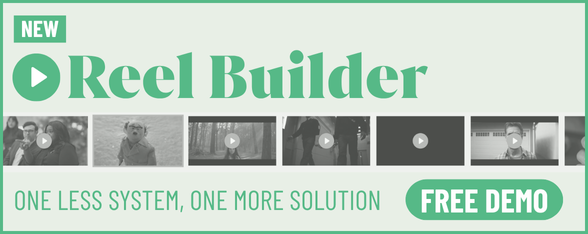
Queensland Production Boom: The Companies to Watch North of the Tweed

Something is happening in Queensland. The sunshine state north of the Tweed River has long been the ambitious younger sibling of its southern counterparts, and any conversation with a Queenslander at State of Origin time will reveal that chip on the shoulder. But after so long spent as the bridesmaid, has Queensland finally become the bride?
With amazing locations, excellent studios, and an emerging labour force to service productions as crews, Queensland is emerging as a production powerhouse. We caught up with some of the emerging and established companies in this space to find out what it is about Queensland that makes it all the more enticing for production crews.
HAPPY
Miles and Angela Murphy can’t believe more people don’t live in Queensland. The New Zealand natives now based out of Brisbane are doting of shooting conditions in the state.
“Queensland has amazing locations, studios, and crew to service production.” Miles says. “Our days are more malleable, with ten hour days and every location you could want.”
And the Murphys who’s production house HAPPY is now five years old, don’t find it too troublesome to compete with the production companies in the state.
“At the end of the day, it comes down to creativity. Big guys will mop up stuff that we don't get access to because their networks are bigger, but if we’re suited to it we’ll get a look. You find a lot of stuff gets done in Brisbane nowadays, there's lots of opportunities for production.”
While also working across Sydney, Melbourne, and New Zealand, to HAPPY, Queensland has all the ingredients a production company needs, including those shooting conditions, but also cost effectiveness, longer working days, and a litany of locations.
“We always say we can get more money on the screen in Queensland. It’s a film-friendly state.”
Miles also notes that the Queensland winter is dry enough to shoot for long days at low light. Mountains, rainforests, cities, beaches; whatever location you could imagine, Queensland has it.
“There are all the different vibes, and it makes a huge difference. If you're shooting outside lifestyle stuff, it'll look better here.”
Miles has noticed a perception since moving up north that Queensland doesn’t have diverse or capable artists and actors. But in his experience, this perception is rubbish.
“I found that out by doing lots of work with different actors and acting schools. We absolutely have the talent here.”
“Queenslanders are fiercely patriotic too, so they want their own ads done up here too. With all the movement in the industry toward becoming more film-friendly, I truly feel this is the place to be.”
Alt.VFX
When Anthony Newton co-founded Alt.VFX 12 years ago, their team of six people were unsure where their next job would come from. Now, with nearly 100 employees, the Alt.VFX, and their subsidiary Steelbridge Studio, are integral parts of the Australian production and post-production landscape.
“We get inquiries almost daily,” Anthony says, not only of brands and agencies, but of other production companies to whom Alt lease their facilities.
Having invested heavily in a Vicon camera system, motion capture technology, and virtual production, ALT are looking to strengthen their position in Australian production as the landscape continues to evolve.
“The traditional 30 second TVC commercial isn't like it used to be, so we're looking at what else is out there. That’s why I tried to combine the different facets of what we have.”
Virtual production has become a cornerstone of ALT’s future strategy, anticipating changes in production timelines and AI technology.
“It isn’t going away, it's going to be getting bigger and bigger. We’ve done three, four different locations in a day. In traditional production, that means driving from one location to another. We can do that all right here. Magic at any time of the day.”
And the state government is keen to incentivise production in Queensland, albeit for longer-form work. While Anthony sees this atmosphere of support as offering “a bit-less love” to companies like his, being robust is likely to allow ALT to make the best of the evolving landscape.
“I honestly think it's going to continue to grow with the government pushing for more training and committing to building studios. I think that there's going to be a continual flow of work from overseas, and also southern states wanting to shoot here. We have the locations, we have the weather, we have the crews. I can't see any reason why we won’t continue to grow.”
Cutting Edge
Given they recently celebrated their 30th birthday, it’s safe to say that Cutting Edge is no stranger to impressive feats. As the largest privately owned post-production company in Australia, surviving the highs and lows of post-production is only part of the story for a company that has now grown to in excess of 100 employees.
Executive producer Trelise Blade puts this down to the family atmosphere of the company.
“Our directors are still here on the ground with us every day and I think for an employee that makes a massive difference,” Trelise says.
Known primarily as a post-production company, the Cutting Edge group has many arms across visual effects and production. But that doesn’t stop them from collaborating with other specialists to make big projects work.
“Love Island, I'm a Celebrity Get Me Out of Here,” Trelise lists them off. “We moved 30 or 40 edit suites into the jungle for that setup,” she says. “We had the cameras and editorial working on site. We are quite big in the sense that we do a lot of different stuff, but – as cliche as it is – we are really like a family.”
Treliese, originally from New Zealand, has been with Cutting Edge for nine years, after a stint agency-side in Sydney. But nothing could keep her away from the sunshine state.
“I moved for the lifestyle, to be completely honest. Queensland is such a beautiful state.”
It's not unusual for Cutting Edge to be celebrating employees’ 10th, 15th, and even 25th work anniversaries. Trelise puts that down to the fact that "no one seems to get bored at Cutting Edge.
“We have the village roadshow lot, we have our Sydney studio. Sydney is predominantly features and television, Brisbane is predominantly short form and advertising. We listen to the market to give people what they need. We do have around 100 full time staff, but we often scale up depending on what's happening.”
Like other production and post-production companies in the state, the 2032 Olympic Games has made the next decade a whole lot more interesting for Cutting Edge.
“We will only see more work. The local agencies naturally are going to be doing a lot of work, which filters down through to us.”















